Elizabeth Stride
Berner Street
Four unsolved murders, an angry press and a complete lack of firm clues. The police were still no nearer any kind of an arrest.
Then the Central News agency received a letter which would give the murderer a special place in the history of crime. It was addressed to the boss and
written in red ink. Though it claimed to be from the killer himself, at first they treated it as a joke. But, realising its potential significance the
agency sent it on to Chief Inspector Donald Swanson, the head of the investigation at Scotland Yard.
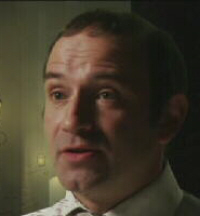
John Bennett
Letter "Dear Boss, I keep on hearing the police have caught me. But, they won't fix me just yet. I have laughed when they look so clever and talk about
being on the right track. That joke about leather-apron gave me real fits. Yours Truly - Jack the Ripper"
John Bennett "There really is nothing to prove that this letter was written by the murderer himself and senior police officials at the time, and modern
commentators have suggested it came from the pen of a journalist. But, whar makes this letter significant and important is it's the one that gave
us that name."
The name was a work of genius and when the murderer struck again the press would be proclaiming the most famous name in criminal history.
Jack would soon return to the streets and in a more shocking way than anything seen before. He would commit two murders on the same night.
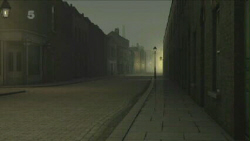
Berner Street
With four unsolved murders, Jack the Ripper would soon strike again, with a murder on 20 September of a 43-year-old woman. She would be the first
of two victims that night in what later became known as the double event. Berner Street off commercial Road was some distance from the other murder
sites. This is what it would have looked like on that September evening.
The east side of the street was a row of houses, one of these was used as a fruit and vegetable shop. On the corner was a pub. Number 40 was an
old three-storey building that had been turned into a socialist club. Alongside was a passage leading into Dutfield's yard. It was here in the early
hours of 30th of September that the body of the woman would be found, her name was Elizabeth Stride, who was actually born in Sweden.
In 1869 she married a man named John Thomas Stride, a carpenter. They had their own coffeehouse in Poplar. Elizabeth was reasonably well-educated.
Bright and intelligent, a linguist and able to run a business. But, things would go wrong. Elizabeth's relationship with John Stride broke up and she
ended up living in a Whitechapel doss house.
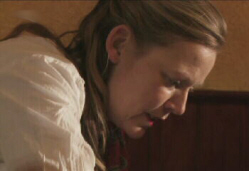
Elizabeth Stride
On 29 September Elizabeth was seen drinking in a pub called the Queens Head, she then returned to her lodging house to smarten herself up to go
out. At 11 PM two labourers were entering the Bricklayers Arms on Settles Street they saw Elizabeth leaving with a man. He was described as short
with a dark moustache and sandy eyelashes. He was wearing a morning suit and coat.
Elizabeth and the man walked quickly away towards Commercial Road. About this time Matthew Packer claimed to have sold grapes to a couple who
came to the shop next to Dutfield's yard. This story received widespread publicity and passed into folklore. However, no remains of grapes
were found in Stride's stomach.
45 minutes later, William Marshall saw Elizabeth with the man on Berner Street. As the meeting in the club finished many people left for home and
for a while, the street was busy. Beside the club some members stayed on to join in some singing. The earlier rain had stopped and the air was fresh.
Around 12.35 PC William Smith saw Elizabeth with a young man at the club. He was described as 5'7" in height, wearing a dark overcoat and a felt
deerstalker hat and was carrying a newspaper parcel.
At 12.45 James Brown left the chandler's shop at the junction of Berner Street where he saw a man and a woman. He remembered the man wearing a
long coat.
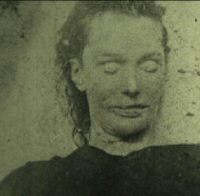
Elizabeth Stride Corpse
Perhaps the most important incident of the entire investigation was from Israel Schwartz, a 22-year-old described as being of Jewish appearance who
spoke no English. He allegedly saw a man throw a woman to the ground, and she screamed three times. Israel thought this was a domestic argument, so
he walked away.
Schwartz later identified the body in the mortuary as being the woman he had seen. Another crucial witness was Fanny Mortimer who lived just
25 feet from the murder scene. She saw a man carrying a Gladstone type bag. The man was Leon Goldstein who was passing through Berner Street
at 1255, placing Mrs Mortimer at her door between 1250 and 1 AM a matter of minutes after Schwartz witnessed the attack outside Dutfield's
yard. This means that the footsteps that she'd heard and believed to belong to a policeman might well have been those of the murderer
leaving the murder scene.
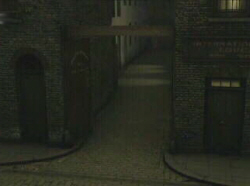
Dutfield's Yard
Looking at Berner Street as it would have appeared on that fateful night it can be seen that Elizabeth Stride's body just inside the passage
to Dutfield yard would not have been visible to Mrs Mortimer even though she was only a matter of yards away. Mrs Mortimer went back inside
and a few minutes later she heard a pony and cart pass by. It was a jewellery salesman named Louis Diemschutz. And on turning into Dutfield
yard, his pony shied refused to go further. The reason soon became apparent. There, at the corner lay the body of Elizabeth stride. Her
throat had been cut.
With four women murdered, the police no nearer an arrest and the public's mounting panic, fuelled by press speculation, the discovery of a fifth
murdered woman discovered in Berner Street was met with disbelief.




